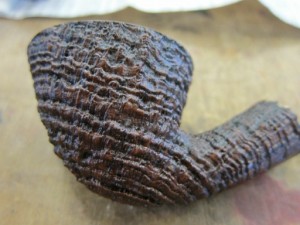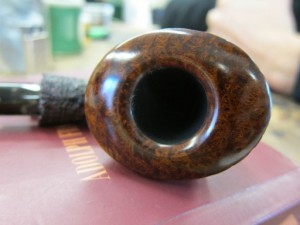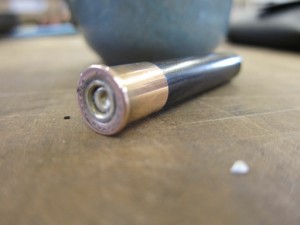The following history was first posted in the Ottawa Pipe Club e-group by Restingpipes and is posted here because I thought it was a great read, and very interesting. Please be sure to read the author’s notes at the end! -ed.
Happy New Year pipers! I hope you are all enjoying your pipes and tobaccos.
Lately I’ve noticed the hand wringing for old blends starting again. Usually it’s about the venerable old blends that are owned by Big Tobacco, though many of the posters appear not to know that. Dunhill blends are the latest example and seem to be a perpetual worry. It’s a rare week lately when one of the pipe boards doesn’t have a thread with a new rumour of pending Dunhill blend loss. It’s old news. The posters often lament Alfred Dunhill Ltd cold modern ways and contrast these with the picture of Alfred Dunhill (himself) selling pipes and tobaccos on a table in front of his wrecked London shop that was demolished by German bombs in WWII. Then someone will voice worries about the pipes. After all if the tobaccos are threatened how long can it be before the company stops making pipes? It’s all very touching but it bears no resemblance to reality.
Reality? The real Dunhill blends disappeared 26 years ago and Dunhill pipes are made by a different corporation than the tobaccos. The tins look the same but that’s the extent of it. What you’re seeing is an effect of modern brand management. The Dunhill tobacco brands themselves have value because we (the buyer) accept that they must be Dunhill tobaccos. We believe the tins. It’s a good trick. But the brands, like the tins, are really just shells that will exist for only as long as they are profitable to their owner. The tin contents are increasingly distorted copies of the Dunhill blends. The contents of the modern tins weren’t made by Alfred Dunhill Ltd. Alfred Dunhill Ltd doesn’t own the Dunhill tobacco brand anymore and hasn’t since 1967. It’s old news.
Semantics? Maybe. But how much change must the actual tobaccos undergo before we stop believing that they’re Dunhill’s? What if they were made in rural China, Japan, or even Denmark with (of course) different tobaccos? These countries have very different tobacco traditions than England and it’s beyond credibility to expect the blends to remain true if manufacturing was moved to one of them and used different tobacco components.
I know. None of this diminishes the worry of loss if you like them, whatever they are. So who does control them?
The Dunhill tobacco brands and blends (pipe tobacco, cigarettes, and cigars) are owned and controlled by BAT – British American Tobacco. BAT is a huge multinational that owns and controls many tobacco brands and it is based in England. Alfred Dunhill Limited (including the pipe making part of the business) is owned by Richemont. Richemont is a large Swiss corporation that specializes in luxury goods. BAT and Richemont are completely separate corporations. Any similarities in behaviour may exist only because they are both responding to declining demand for all things related to pipes.
Ok, but one hopes the ‘blend lie’ is a white one. Did BAT buy the Dunhill tobacco brands from Alfred Dunhill Ltd? Is the chain of ownership short enough that the blends might be close to the originals? Nope.
Carreras International bought a controlling interest in Alfred Dunhill Ltd in 1967. Carreras left manufacturing of the Dunhill blends with the Dunhill factory. Carreras already owned Murray Sons & Company and all their blends (since 1953). Murray’s tobacco plant too – Whitehall Tobacco Works – continued under Carreras. The corporate owner may have changed to Carreras but the manufacturing location and people making the tobacco didn’t. There was blend continuity. Carreras was a blend-friendly owner. Then in 1972 Rothman’s bought Carreras; enter the modern era in brand management. In 1981 Rothman’s moved Dunhill blend manufacturing to Murray Sons & Company in Belfast. Rothmans consolidated manufacturing for all of their pipe tobacco brands into Murray’s. That broke the blend continuity chain for Dunhill tobaccos. Different people and different tobaccos were used for the first time, but not the last, in making Dunhill tobaccos.
In 1993 Rothmans diversified their holdings into two broad categories – luxury goods and tobacco. While the luxury-good-tobacco association worked well in the 80’s (remember life style ads?) tobacco was coming under attack in the 90’s. Rothman’s spun off the luxury goods part of the company as Richemont in 1993. Dunhill pipes and the Alfred Dunhill brands went with Richemont. Dunhill tobaccos stayed with Rothmans in their core tobacco business. In 1999 BAT bought Rothman’s International and starting in 2004 improved the brand profitability by optimizing their manufacturing plants. In 2005 Whitehall Tobacco Works, Murray Sons & Co manufacturing plant was closed and sold. BAT outsourced manufacturing of all their pipe tobacco blends to Orlik in Denmark.
Blend availability is confusing when judged by what online sellers are offering. Synjeco’s in Switzerland doesn’t have some of the blends that are still available from sellers in Germany. One can’t conclude that the blends aren’t being manufactured anymore only that some aren’t sold in some regions. BAT is very selective about where they market and sell which blends. You can see this for yourself by visiting their ingredient reporting site (follow the ‘What’s in my brand’ selection on the left):
http://www.bat-ingredients.com/
Are they still Dunhill pipe tobaccos? They’re a faint copy. But BAT will continue this charade until they’re no longer profitable.
AUTHOR’S NOTES
- This article is more of an opinion/editorial piece intended to encourage discussion, rather than a dispassionate history.
- It’s partly an answer to questions as to why it’s so hard to predict or document BAT’s pipe tobacco brand availability.
- There are probably inevitable errors in the history. For example, the division of Rothman’s into luxury goods and tobacco companies is more complex than indicated and it’s probably somewhat more accurate to say Richemont spun off the tobacco business as Rothman’s International rather than the other way around.
As an interesting qualification on the second bullet, there are numerous examples of inaccurate info posted by almost everybody (including me), concerning BAT brands and blend availability. This goes back years including retailer/distributor posts on ASP, retailer web sites world wide, individual email correspondence with BAT etc etc. The level of inaccuracy in reports is incredible. It’s clearly a confusing topic. From Synjeco’s to McGahey’s to Watch City in the US, and even in private posts, they’ve all reported availability ‘facts’ that turned out not to be true. Or at least the ‘facts’ weren’t true everywhere. The ‘truth’ about brand/blend availability seems to only have ‘local’ relevance when dealing with BAT owned brands & blends.








